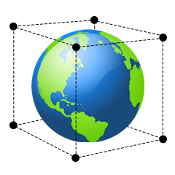To live effectively, an individual must constantly communicate (ongoing exchanges of information with various changing environments such as home, business or government).
Language, culture and interactivity are the three filters of analysis that create links between the thinking of a group of human beings and where they are situated in time and space :
Throughout history, humans have managed to communicate daily with their world by developing textual, visual and audio interfaces. Recently, these interfaces have evolved, setting the stage for humans to adapt to the massive societal changes underway (chapter 5, no 9) :

The network effect
Since 1960, we have developed three types of networks that operate according to three different laws :

A- Sarnoff’s Law: n + n (1950) (television pioneer)
The public is added to as and when it uses various media systems (eg mass media) (chapter 5, no 6).
B- Moore’s Law: nx2 (1965) (computer pioneer)
New electronic circuits double the processing performance for data every 18 to 24 months (chapter 5, no 7). (Examples : fax, phone, email, etc.)
C – Metcalfe’s Law: n2 (1980) (communications pioneer)
Because of geolocation, the potential of a network is multiplied by the square number of users (eg social networks). (Complete with the law of Reed, 2001).
A system that reflects the transition
If we add in the various changes that are emerging, it becomes clear that a much more complex society is under construction :

A non-validated information system
Not so very long ago the mass media broadcast information that was filtered and mediated by professional journalists who followed a code of ethics. Today the sources of creation and dissemination have multiplied : social networks like Facebook or Twitter, specialized networks like LinkedIn, distribution channels like Netflix or HBO, blogs, citizen journalists, and emails from ordinary citizens.
These sources of Big Data are typically not validated : there are too many half-truths and out-of-context erroneous information, rumors and opinions. Even images are often retouched or modified with special effects.
This raises a credibility problem and a problem of content validity. Who and what are we supposed to believe now ?
A dangerous ecosystem of mis-information
In the US, this ecosystem disseminates large-scale falsehoods. It has become commonplace to accept lies that deceive the people and distort democracy.
Recent major lies :
- Saddam Hussein’s Iraq possessed nuclear weapons.
- massacres of civilians in Afghanistan and Iraq (disguised as collateral damage).
- assassinations by drones.
- smear campaigns against Castro (Cuba) and Hugo Chavez (Venezuela), etc.
- media offensives promoting the benfits of austerity to the general public.
- anti-Wikileaks campaigns (Assange, Snowden, etc.) as unpatriotic individuals or groups, etc.
Communication in the United States :
To live effectively, an individual must constantly communicate (ongoing exchanges of information with various changing environments such as home, business or government).
Language, culture and interactivity are the three filters of analysis that create links between the thinking of a group of human beings and where they are situated in time and space :
Throughout history, humans have managed to communicate daily with their world by developing textual, visual and audio interfaces. Recently, these interfaces have evolved, setting the stage for humans to adapt to the massive societal changes underway (chapter 5, no 9) :

The network effect
Since 1960, we have developed three types of networks that operate according to three different laws :

A- Sarnoff’s Law: n + n (1950) (television pioneer)
The public is added to as and when it uses various media systems (eg mass media) (chapter 5, no 6).
B- Moore’s Law: nx2 (1965) (computer pioneer)
New electronic circuits double the processing performance for data every 18 to 24 months (chapter 5, no 7). (Examples : fax, phone, email, etc.)
C – Metcalfe’s Law: n2 (1980) (communications pioneer)
Because of geolocation, the potential of a network is multiplied by the square number of users (eg social networks). (Complete with the law of Reed, 2001).
A system that reflects the transition
If we add in the various changes that are emerging, it becomes clear that a much more complex society is under construction :

A non-validated information system
Not so very long ago the mass media broadcast information that was filtered and mediated by professional journalists who followed a code of ethics. Today the sources of creation and dissemination have multiplied : social networks like Facebook or Twitter, specialized networks like LinkedIn, distribution channels like Netflix or HBO, blogs, citizen journalists, and emails from ordinary citizens.
These sources of Big Data are typically not validated : there are too many half-truths and out-of-context erroneous information, rumors and opinions. Even images are often retouched or modified with special effects.
This raises a credibility problem and a problem of content validity. Who and what are we supposed to believe now ?
A dangerous ecosystem of mis-information
In the US, this ecosystem disseminates large-scale falsehoods. It has become commonplace to accept lies that deceive the people and distort democracy.
Recent major lies :
- Saddam Hussein’s Iraq possessed nuclear weapons.
- massacres of civilians in Afghanistan and Iraq (disguised as collateral damage).
- assassinations by drones.
- smear campaigns against Castro (Cuba) and Hugo Chavez (Venezuela), etc.
- media offensives promoting the benfits of austerity to the general public.
- anti-Wikileaks campaigns (Assange, Snowden, etc.) as unpatriotic individuals or groups, etc.
Communication in the United States :




Leave A Comment